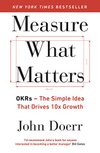
Saved by Eric Johnson and
Measure What Matters: OKRs: The Simple Idea that Drives 10x Growth

Saved by Eric Johnson and
OKRs surface your primary goals. They channel efforts and coordination. They link diverse operations, lending purpose and unity to the entire organization.
An OBJECTIVE, I explained, is simply WHAT is to be achieved, no more and no less. By definition, objectives are significant, concrete, action oriented, and (ideally) inspirational. When properly designed and deployed, they’re a vaccine against fuzzy thinking—and fuzzy execution.
Where an objective can be long-lived, rolled over for a year or longer, key results evolve as the work progresses. Once they are all completed, the objective is necessarily achieved. (And if it isn’t, the OKR was poorly designed in the first place.)
My objective that day, I told the band of young Googlers, was to build a planning model for their company, as measured by three key results: KR #1: I would finish my presentation on time. KR #2: We’d create a sample set of quarterly Google OKRs. KR #3: I’d gain management agreement for a three-month OKR trial.
KEY RESULTS benchmark and monitor HOW we get to the objective. Effective KRs are specific and time-bound, aggressive yet realistic. Most of all, they are measurable and verifiable. (As prize pupil Marissa Mayer would say, “It’s not a key result unless it has a number.”) You either meet a key result’s requirements or you don’t;
First, said Edwin Locke, “hard goals” drive performance more effectively than easy goals. Second, specific hard goals “produce a higher level of output” than vaguely worded ones.
Ideas are easy. Execution is everything.
This book—with its companion website, whatmatters.com—is my chance to bring a long-held passion to you, my reader. I hope you find it useful. I can tell you it has changed my
My objective has two key results: win the Super Bowl and fill the stands to at least 90 percent capacity, which is HOW I will make money for the owner. If I fulfill both of those HOWs, there is no way we can fail to show a profit. So it’s a well-constructed OKR.
This seems to be key. The key results have to guarantee reaching the objective